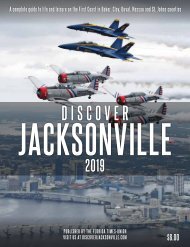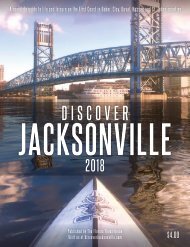Create successful ePaper yourself
Turn your PDF publications into a flip-book with our unique Google optimized e-Paper software.
Blue Angels pilots<br />
promotional photo,<br />
Pensacola, 1957<br />
Photo courtesy of Ron Williamson<br />
The birth of the United States Navy<br />
Photo by Petty Officer 2nd Class Nathan Wilkes<br />
Sailors celebrate the U.S. Navy's 241st birthday aboard the amphibious assault ship USS Wasp (LHD 1) Oct. 12, 2016. Wasp was deployed with<br />
the Wasp Amphibious Ready Group to support maritime security operations and theater security cooperation efforts in the U.S. 6th Fleet area of<br />
operations.<br />
On Friday, October 13, 1775, meeting in<br />
Philadelphia, the Continental Congress voted to<br />
fit out two sailing vessels, armed with ten carriage<br />
guns, as well as swivel guns, and manned by<br />
crews of eighty, and to send them out on a cruise<br />
of three months to intercept transports carrying<br />
munitions and stores to the British army in<br />
America. This was the original legislation out of<br />
which the Continental Navy grew and as such<br />
constitutes the birth certificate of the navy.<br />
To understand the momentous significance<br />
of the decision to send two armed vessels to sea<br />
under the authority of the Continental Congress,<br />
we need to review the strategic situation in<br />
which it was made and to consider the political<br />
struggle that lay behind it.<br />
Americans first took up arms in the spring<br />
of 1775, not to sever their relationship with<br />
the king, but to defend their rights within the<br />
British Empire. By the autumn of 1775, the<br />
British North American colonies from Maine to<br />
Georgia were in open rebellion. Royal governments<br />
had been thrust out of many colonial<br />
capitals and revolutionary governments put<br />
in their places. The Continental Congress had<br />
assumed some of the responsibilities of a central<br />
government for the colonies, created a Continental<br />
Army, issued paper money for the support<br />
of the troops, and formed a committee to negotiate<br />
with foreign countries. Continental forces<br />
captured Fort Ticonderoga on Lake Champlain<br />
and launched an invasion of Canada.<br />
In October 1775 the British held superiority<br />
at sea, from which they threatened to stop up the<br />
colonies’ trade and to wreak destruction on seaside<br />
settlements. In response, a few of the states<br />
had commissioned small fleets of their own for<br />
defense of local waters. Congress had not yet authorized<br />
privateering. Some in Congress worried<br />
about pushing the armed struggle too far, hoping<br />
that reconciliation with the mother country was<br />
still possible.<br />
Yet, a small coterie of men in Congress had<br />
See NAVY BIRTHDAY, Page 18<br />
ó 2017 NAS Jax Air Show ó 15

















